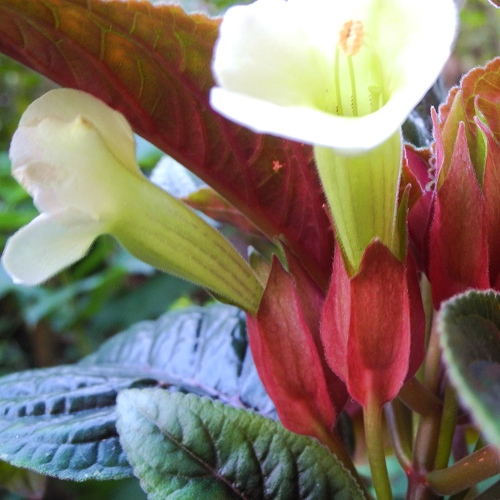Germinating the seeds
Getting started -- Plant your seeds when you receive them. Use several small pots or cups with drainage holes, about 2-4 inches (5-10 cm) tall. Use a well-draining soil mix. I use
a mix of 1 part
coco fiber The seeds are small, so work in a well-lit area. Sprinkle a few seeds evenly across the surface of each pot. An easy way to pick up the seeds is by breathing on your finger tip to lightly moisten it, then dabbing the seeds with it. Don't sow them too densely, because the germination rate is high. Next sprinkle a thin layer of long-fibered sphagnum moss (not ground peat moss). This helps retain moisture around the seeds while allowing light to reach them, which aids germination. This photo shows how much moss to use. If you don't have sphagnum moss, sprinkle a bit of your soil mix around the surface. Add water until the soil is evenly moist, but not soggy. Until the seeds sprout, ensure that the soil surface never dries out. An easy way to maintain high humidity by enclosing the pots in a plastic container or bag. Leave it open slightly to let in fresh air. You may need to drip a few drops of water on the surface once or twice a day to keep it moist. The seeds germinate well between about 65-80 degrees F (18-27°C). I don't have experience germinating them outside this temperature range. I recommend placing a minimum/maximum thermometer next to the pots. Place the containers in a bright spot out of direct sun. An LED or fluorescent lamp kept 4 inches (10 cm) away provides the right amount of light (See: "Growing indoors with LED lights"). The seeds should start sprouting within about 4-6 weeks, but might take longer. Continue dripping water on the soil surface after they sprout, since young seedlings have a small root system. Increase the air ventilation slightly after they sprout to prevent rot. When the seedlings are 6-8 weeks old, you may carefully dig them up and transplant them, or cut away any slower ones, leaving 1 strong seedling in each pot. Fertilizing -- The first 2 months, feed
weekly with a small amount of dilute (1/8 strength) liquid fertilizer.
Hydroponic fertilizer
is ideal for small seedlings, because it is easily absorbed and contains all essential
nutrients. After 2 months, you may switch to a granular fertilizer Watering -- Once the seedlings are 4 weeks old, you may stop keeping the soil surface moist at all times. Aim to keep the rest of the soil evenly moist (but not soggy). Lighting -- The plant likes filtered sun or bright shade + morning sun. Protect it from strong afternoon sun. Transplanting -- When the seedlings are 2 months old, repot to a 1 quart (1 liter) container. Water the soil before repotting, to keep the soil ball from breaking apart, which can damage the roots. Climate -- It grows well for me in warm indoor conditions with a drop in temperature at night, similar to intermediate-temperature orchids. I haven't tried it in cooler conditions. I presume it will be unhappy below 55 degrees F (13°C), although its tuber could probably survive a light frost. Over about 50% humidity seems to be best. If they seems to suffer from low humidity indoors, consider using an ultrasonic humidifier, sold at home improvement stores and some thrift shops. Dormancy -- The plant can through a rest period some time after flowering. Some or all of the leaves may drop off during this time. Do not remove any stems unless they are dead, since new growth will emerge from the stems. If you have any questions or problems, feel free to contact me. Have fun growing them! - Jeff Strange Wonderful Things
|
|||||||||


